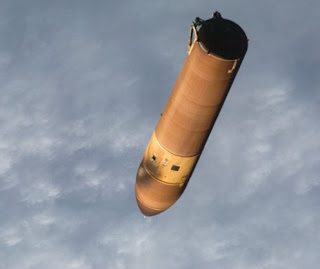Recently one of my brother had asked a review of launch of space shuttle for his school assignment. So i thought it would been nice to use in my blog. We don't get chance to see the shuttle launch live. If u got any Picture or interesting information , share with us.! Correct me if anything wrong!

At Lift-off, the shuttle is made of:
Winged orbiter- where the astronauts travel
A Huge fuel tank (External Tank)- which supplies fuel to the orbiter's three main engines and
Two Solid Rocket Booster (SRB) attached to the fuel tank
The Fuel tank contains liquid oxygen and hydrogen.
The booster rockets use Solid Fuel.
They both work like huge fireworks, and cannot be switched off after ignition.

The orbiter also has two smaller engines called the orbital manoeuvrings system(OMS), and clusters of small gas-powered thrusters at the nose and tail, used for small manoeuvrings in orbit.
The picture shows the Orbiter's partial views of the shuttle's main engines, orbital maneuvering system (OMS) pods, a portion of the payload bay door panels and the shuttle's wings.
The Launch of shuttle is Explained here:
1.Lift-off
3. The booster rockets(SRB) last for two minutes, then separate from the fuel tank and parachute back to the earth for re-use.


4. The fuel in the External tank runs out after nine minutes, after which the orbiter jettisons it and the external tank falls back into the atmosphere, where it burns up because of the intense heat created.
5. The orbiter are now on its own. The OMS engines are fired for a short time to accelerate the orbiter into its correct orbit.
Less than 15 minute after the launch, the shuttle is in orbit at an altitude of about 200 km. Now the astronauts can carry out their mission.
 6. With the mission complete, the OMS engines slow down the orbiter so that it begins to fall back to Earth.
6. With the mission complete, the OMS engines slow down the orbiter so that it begins to fall back to Earth.During re-entry into the atmosphere, heat-resistant ceramic tiles protect the orbiter from the intense heat. It gradually slows as it descends, and finally glides back on to a runway like an aeroplane.
(In Picture, the Orbiter deploys the landing gear before landing on a selected runway just like a common aircraft)
To return to Earth the space shuttle must make a series of complicated manouevres to align itself into the correct position to achieve a safe descent:
1. The shuttle flies upside down in orbit to control its heating.
2. To re-enter the atmosphere, the shuttle is turned tail first to the direction of travel, and fires its engines to slow its speed.
3. The orbiter is then flipped the right way up and enters the top layer of the atmosphere at about a 40-degree angle from horizontal with its wings level.
4. The orientation keeps its black thermal tiles facing the majority of the heat - as high 1,650C (3,000F) on the leading edges of the wings and nose.
5. As its speed drops, the shuttle starts to fly more like an aircraft, using its rudder and wing flaps for control. It banks sharply to slow its speed still further
6. The shuttle falls from a height of more than 360km at speeds that top Mach 30, and at an angle of 19 degrees, far steeper than that of a commercial aircraft. The spacecraft comes to a dead stop half a world a way from where it began the descent.






No comments:
Post a Comment